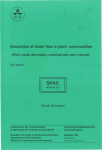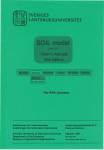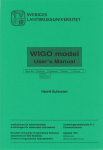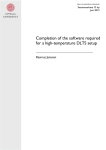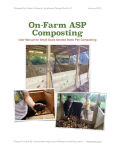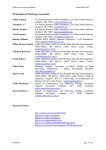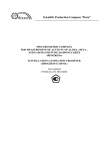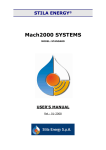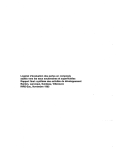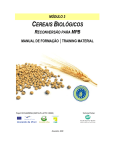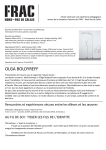Download "user manual"
Transcript
R-06-47 A model of accumulation of radionuclides in biosphere originating from groundwater contamination Annemieke Gärdenäs Department of Soil Sciences Swedish University of Agricultural Sciences Per-Erik Jansson, Louise Karlberg Department Land and Water Resources Royal Institute of Technology March 2006 CM Gruppen AB, Bromma, 2006 Svensk Kärnbränslehantering AB Swedish Nuclear Fuel and Waste Management Co Box 5864 SE-102 40 Stockholm Sweden Tel 08-459 84 00 +46 8 459 84 00 Fax 08-661 57 19 +46 8 661 57 19 ISSN 1402-3091 SKB Rapport R-06-47 A model of accumulation of radionuclides in biosphere originating from groundwater contamination Annemieke Gärdenäs Department of Soil Sciences Swedish University of Agricultural Sciences Per-Erik Jansson, Louise Karlberg Department Land and Water Resources Royal Institute of Technology March 2006 This report concerns a study which was conducted for SKB. The conclusions and viewpoints presented in the report are those of the authors and do not necessarily coincide with those of the client. A pdf version of this document can be downloaded from www.skb.se Abstract The objective of this study is to introduce a module in CoupModel /Jansson and Karlberg 2004/ describing the transport and accumulation in the biosphere of a radionuclide origi nating from a ground water contamination. Two model approaches describing the plant uptake of a radionuclide were included, namely passive and active uptake. Passive uptake means in this study that the root uptake rate of a radionuclide is governed by water uptake. Normal mechanism for the passive water uptake is the convective flux of water from the soil to the plant. An example of element taken up passively is Ca. Active plant uptake is in this model defined as the root uptake rate of a radionuclide that is governed by carbon assimilation i.e. photosynthesis and plant growth. The actively taken up element can for example be an element essential to plant, but not available in high enough concentration by passive uptake alone, like the major nutrients N and P or an element that very well resembles a plant nutrient, like Cs resembles K. Active uptake of trace element may occur alone or in addition to passive uptake. Normal mechanism for the active uptake is molecular diffusion from the soil solution to the roots or via any other organism living in symbiosis with the roots like the mychorrhiza. Also a model approach describing adsorption was introduced. CoupModel /Jansson and Karlberg 2004/ dynamically couples and simulates the flows of water, heat, carbon and nitrogen in the soil-plant-atmosphere system. Any number of plants may be defined and are divided into roots, leaves, stem and grain. The soil is considered in one vertical profile that may be represented into a maximum of 100 layers. The model is the windows-successor and integrated version of the DOS-models SOIL and SOILN, which have been widely used on different ecosystems and climate regions during 25 years time period. To this soil-plant-atmosphere model were introduced a module describing accumula tion of a radionuclide in the biosphere originating from groundwater contamination. The radioactive element is represented as a state variable in different plant parts (stem, leaves, roots and grain) and in soil layers as attached to soil organic matter fractions (litter and humus), solved in soil water solution and adsorbed to soil particles. The importance of the different plant uptake models and their parameterization for accumulation of radio nuclides in the biosphere was demonstrated by a model application of a mature boreal forest for a 20-years-period with an initial single pulse groundwater contamination. The passive uptake approach was used to demonstrate importance of root depth, allocation to leaves and different scaling to the water uptake rate. The active uptake approach was used to demonstrate the importance of adsorption fraction, bioavailability and optimum ratio of leaf carbon and radionuclide. After 20 years, 9% of the originally added radionuclide had accumulated in the biosphere when assuming no plant uptake. Corresponding numbers for passive and active uptake were 12–37% and 35–44% respectively. The percentages accumulated using passive uptake was most sensitive to tested range of rooting depth and ones using active uptake to tested range of optimum ratio of leaf carbon and radionuclide. We conclude that the introduced module was able to simulate different possible plant uptake mechanisms and hydrological conditions. Further dynamically modeling studies are important to analyze the effect of a continuous contamination on long-term (10,000 years) accumulation in biosphere for various specific radionuclides, ecosystems and climatic conditions. Contents 1 Introduction 2 2.1 2.2 2.3 2.4 Model description General Water and heat model Carbon and nitrogen model Radionuclide model 9 9 9 10 10 3 Model application and sensitivity analysis 15 7 4 Results and discussion 4.1 General 4.2 Sensitivity analysis 17 17 19 5 Conclusions 23 6 Acknowledgement 24 7 References 25 Appendix 1 Model exercise “Accumulation of water solutes in biosphere” 27 1 Introduction For a risk assessment of final deposit of radioactive fuel residues, it‘s necessary to estimate the possible accumulation of a radionuclide in the biosphere from an eventual groundwater contamination. The potential accumulation in the biosphere is often estimated by water uptake rate and concentration of a radionuclide in soil water, here after called passive uptake. It’s known that a radionuclide can be taken up in higher concentration than can be explained by the convective water uptake. In such a case, the ultimate driving force may be the carbon assimilation and the typical mechanism for uptake may be the molecular diffusion. In this model, we call the uptake that is driven by the carbon assimilation active uptake. (Please, be aware that active uptake might be somewhat different defined than commonly used in plant physiology). The two uptake approaches of radionuclides can be combined to describe any specific radionuclide accumulation in biosphere originating from a groundwater contamination. Estimation of uptake of a radionuclide also has to take into account the difference in function between the unsaturated and the saturated zone of the soil profile. Many plants will have roots that will not survive in the saturated zone whereas others may take up water and nutrients both under unsaturated and saturated conditions. The contamination with radioactive element is assumed to take place in the saturated zone. Consequently, it’s important to understand how plant uptake may take place directly from the saturated zone and how radionuclides may be transported from saturated to unsaturated conditions in the soil. The depth, at which the saturated zone starts, the so-called ground water table, fluctuates with season and topographical position in the landscape. So can in a recharge area, the groundwater table temporary rise into the normally unsaturated root zone and could contaminate the root zone with a dissolved radioactive. These phenomena can be described and quantified using a dynamic, deterministic model describing both soil hydrology and plant development in detail. The CoupModel /Jansson and Karlberg 2004/ is such a model. It’s well-known for its coupling of detailed descriptions of the water, heat, carbon and nitrogen balances in the plant-soil-atmosphere system and has a large number of applications both on natural and managed ecosystems, within cold-temperate climate and other climate regions /e.g. Stähli et al. 2001, Karlberg 2002, Gustafsson 2002/. The aim of the study was to introduce a module in CoupModel /Jansson and Karlberg 2004/ describing the transport and accumulation in the biosphere of a radionuclide originating from a ground water contamination. Two model approaches describing the plant uptake of a radionuclide were introduced namely a) passive uptake governed by water uptake and b) active uptake governed by carbon assimilation. The radionuclide module was designed as a general tracer element module. A radioactive (or any other trace element) was imple mented in the CoupModel as a state variable in different plant parts (stem, leaves, roots and grain) and in soil layers as part of soil organic matter fractions (litter and humus), solved in soil water solution and adsorbed to soil particles. The model development was demonstrated with application of a mature boreal forest for a 20-years-period with an initial single pulse groundwater contamination with a radionuclide. The importance of the different plant uptake approaches and their parameterization for accumulated percentage of added radio nuclide was tested. A tutorial how to use the module is given in the appendix. 2 Model description 2.1 General In CoupModel /Jansson and Karlberg 2004/, the flows of water, heat, carbon and nitrogen in the soil-plant-atmosphere system are dynamically coupled. The nitrogen and carbon balances of an ecosystem strongly depend on the water and heat balances, as processes like growth and decomposition depend on the soil temperature and moisture content. The water and heat balances, in turn are influenced by the carbon and nitrogen balances, e.g. water uptake varies with growth rate and N fertilization. CoupModel is the windows-successor and coupling version of the DOS-models SOIL /Jansson and Halldin 1979, Jansson 1998/ and SOILN /Johnsson et al. 1987, Eckersten et al. 1998/, which have been widely used on different ecosystems and climate regions during 30 years time /e.g. Espeby 1992, Gärdenäs and Jansson 1995, Eckersten et al. 1995, 1999, Gustafsson et al. 2004/. It is a one-dimen sional, deterministic model with the partial differential equations of water and heat flow solved by using an explicit forward difference method called the Euler integration. Plants are divided into compartments root, leaves, stem and grain and soils into a maximum of 100 internally homogenous layers with specified properties like hydraulic conductivity, litter content and root density. /Jansson and Karlberg 2004/ compromises a complete documentation of the CoupModel, which is regular updated on webpage www.lwr.kth. se/vara%20datorprogram/CoupModel. Below are given short descriptions of the water and heat and the carbon and nitrogen models and a full description of the introduced uptake models of a radioactive including its equations. In the CoupModel documentation, the uptake models are part of the salt tracer module (see www.lwr.kth.se/vara%20datorprogram/CoupModel). A tutorial for modeling uptake and transport of a water solute in the biosphere is given in Appendix 1. 2.2 Water and heat model Water flow is estimated by combining Darcy’s law for water flow with the law of mass conservation. Analogue is heat flow estimated by combining Fourier’s heat flow law and the law of energy conservation. Soil physical properties may be defined with various degrees of vertical resolution and heterogeneity for a soil profile. Typical characteristics are the water retention curve, functions for the hydraulic conductivity, heat capacity and water uptake response. Water is lost through transpiration, soil evaporation, evaporation of intercepted water (called interception), deep percolation and surface run off. Potential transpiration is modeled according to the Penman-Monteith equation /Monteith 1965/. Records of air temperature, precipitation, wind speed, relative humidity, and global radiation are used as driving variables. Plant development is described with a dynamic behaviour where height of plant, root depth and Leaf Area Index (LAI, i.e. the number of leaf layers projected on ground surface) are described as functions of plant biomass. The canopy conductance is estimated according to the Lohammar-equation /Lohammar et al. 1980/ as a function of the global radiation, saturation deficit and LAI. The CoupModel is among water balance models well-known for its details of describing the heat balance processes, including freezing and thawing, with high temporal resolution /Stähli et al. 1999/. This is of great importance for correct modeling of N cycling of boreal forests, e.g. N transport with high water flow after snowmelt and the effect of thawing on mineralization. 2.3 Carbon and nitrogen model The nitrogen and carbon balances were modeled using the simulated daily variation in water and heat flows as driving variables. The carbon and nitrogen balances strongly interact. Photosynthesis (C uptake) is driven by global radiation /cf. de Wit 1965/, and is limited by low needle nitrogen status /cf. Ingestad et al. 1981/. At the same time, photosynthesis determines the plant N demand. Available nitrogen for plant uptake depends on N deposi tion, N fertilization, N mineralization, uptake of organic N by symbiosis with mycorrhiza and losses as N leaching. N mineralization is determined by soil temperature and moisture, microbial activity and biomass, the C/N ratio and the amount of soil organic matter. Uptake of organic N by symbiosis with mycorrhiza is described with a first order rate coefficient and limited by the amount of soil organic matter in each fraction and the excess of available mineral N. Soil organic matter is fractionated into a surface pool of fresh litter, litter and humus. Microbes may be described by a separate pool or considered as a part of the soil organic matter, while mycorrhiza may be considered as incorporated into the root biomass pool. The plants (trees and ground vegetation) are divided in roots, leaves/needles, stems and grains. The roots, leaves and stems are divided into current year and old biomass. Each pool in the soil layers and plant have an initial defined carbon and nitrogen content. Especially the root depth and root distribution patterns are important feed back mechanism between the hydrological conditions and the dynamics of nitrogen and carbon. Plant charac teristics like photosynthesis efficiency, litter rate, and allocation pattern between root/shoot can be parameterized and changed to represent plant age, species and/or climatic region. 2.4 Radionuclide model The model of cycling of a radioactive element is defined as a general model of a trace element cycling in the soil-plant-atmosphere system. The trace element is denoted with the abbreviation TE throughout the model description. State variables [mg TE m–2] of the tracer element in all plant parts (e.g. TELeaf, TELeafold, TEStem, TEStemold, TERoot TERootold and TEGrain), all soil organic matter fractions (e.g. TESurfaceLitter, TELitter and TEHumus) and mineral pool TEMin (including both dissolved in soil solution and adsorbed to soil) in each soil layer were included (Figure 2-1). Trace elements can enter the soil-plant-air system either as an initial concentration in the soil layers, TEIni(z) [mg TE l–1], or as a constant groundwater TE flux qTEin [mg TE day–1] by means of a constant water flow qsol [mm day–1] with a constant concentration TEConcSoFlow [mg l–1] in a specific soil layer zsof [m]. It can leave the system by deep percolation qTEdp or drainage, qTEdr [mm day–1]. The description of trace element fluxes between one state variable to another have much in common with those of nitrogen. Fluxes due to uptake, allocation to grain and old plant parts, decomposition and mineralization are described in detail in following sections. 10 STEGrain STELeaf STEOldLeaf STEStem STEOldStem qTE in STESurfaceLitter STEPlantUpt STEOldRoots STERoots STELitter STEMin STEHumus qTE dr + qTE dp Figure 2-1. The storage and fluxes of trace elements in the model. Passive plant uptake Passive uptake of a trace element (denoted with PU) is governed by plant water uptake, Wupt [mm day–1], the trace element concentration in soil water (denoted with subscript c) TEcr [mg l–1] in the root zone (denoted with r) and a dimensionless scaling factor represent ing degree of convective transport pPUscale [–], where zero means no convective uptake and one full convective uptake. The uptake is calculated separately for the leaf, stem and roots compartment, with for the compartment specific allocation fraction of the total passive uptake (fPULeaf, fPUStem, and fPURoot for leaf, stem and root respectively, all dimensionless). For example, passive trace element uptake from the mineral pool of one soil layer to the leaf, TEMin→Leaf, is calculated as: TEMin→ Leaf ( z ) = TEc ( z ) ⋅ Wupt ( z ) ⋅ pPUscale ⋅ f PUleaf [mg TE day–1] (2.1) Analogue equations are used to calculate the passive uptake to stem, TEMin→Stem(z) and roots, TEMin→Roots(z) by exchanging fPULeaf to fPUStem or fPURoot respectively. The root fraction, fPURoot, is set to: f PURoot = 1 − ( f PULeaf + f PUStem ) [–] (2.2) The total passive uptake of trace elements, TEPUMin→Plant [mg day–1], is the sum of the passive uptake to the leaves, stem and roots. The sum is also made over all the different layers from which a water uptake rate, Wupt(z), is simulated. 11 Active plant uptake Active uptake (denoted with AU) can take place in addition to passive uptake or alone. Active uptake of a trace element to each plant compartment is governed by the carbon assimilation of the respective plant compartment (Ca→Leaf, Ca→Stem, and Ca→Root [g C day–1]) and the trace element concentration in the root zone, TEcrMin. For example, the active trace element uptake from a soil layer of the mineral pool to the leaf, TEMin→Leaf(z), is calculated as: TEMin→ Leaf ( z ) = zr ⋅ TEcAU ( z ) ⋅ Ca → Leaf [mg TE day–1] (2.3) where zr [–] is the relative depth/thickness z of the root zone r. TEcAU(z) is the concentration/ ratio of trace elements actively taken up and calculated as follows: TEcAU ( z ) = min(( TEc ( z ) ),1) ⋅ p AUrLeaf [mg TE gC–1] p AUcBio where pAUcBio reflects the bioavailability, i.e. a threshold concentration of the trace element in the soil solution. Above this threshold concentration is the trace element uptake ratio equal to the maximum ratio of trace element and new carbon assimilates of respective plant compartment, denoted with pAUrLeaf, pAUrStem and pAUrRoot [mg TE gC–1] for new leaf, stem and roots assimilates respectively. Analogous equations are used to calculate the active uptake to stem, TEMin→Stem, and roots, TEMin→Roots(z), by exchanging pAUrLeaf to pAUrStem or pAUrRoot, and Ca→Leaf to Ca→Stem or Ca→Root, respectively. The total active uptake of trace elements, TEAUMin→Plant, is the sum TEMin→Leaf, TEMin→Stem and TEMin→Roots(z) after integration over the different soil layers. Allocation of trace elements to the grain and old plant pools Allocation of trace elements to the grain pool from roots, leaves and stem is proportional to the carbon fluxes and the ratio of trace element and carbon content of the respective plant source pool. For example, the transfer of trace elements from leaves to grain, TELeaf→Grain, is calculated as: TELeaf →Grain = CLeaf →Grain ⋅ TErLeaf [mg TE day–1] (2.4) where CLeaf→Grain is the flux of carbon from leaves to grain. TErLeaf is the ratio of trace element and leaf carbon: TErLeaf = TELeaf CLeaf [mg TE gC–1] (2.5) where TELeaf is the trace element content of leaves and CLeaf is the carbon content of leaves. The transfers of tracers from roots to grain, TERoot→Grain, and from stem to grain, TEStem→Grain, are calculated analogously. For applications north of equator, every 1st of January, the amount of trace elements of the current year pool TELeaf, TEStem and TERoots are transferred to pools for old plant material, i.e. TEOldLeaf, TEOldStem and TEOldRoots. For applications south of the equator, this is done on 1st of July every year. 12 Trace element fluxes in litter formation and decomposition Trace element fluxes with litterfall from leaves, stem, grain and roots are calculated in the same manner as trace element fluxes to grain; i.e. in proportion to carbon fluxes and the ratio of trace element and carbon content of the respective plant source pool. Trace elements originating from above ground plant parts accumulate in the surface litter, TESurfaceLitter [mg TE m–2]. From the surface litter, there is a constant flux of trace elements into the litter pool in the uppermost soil compartment, TELitter(z1) [mg TE m–2], calculated as: TESurfaceLitter → Litter ( z1 ) = ll1 ⋅ TE SurfaceLitter [mg TE day–1] (2.6) where ll1 is a rate coefficient [day–1] that is assumed similar as for carbon and nitrogen Below ground litter production, i.e. root litter, goes directly to the litter compartment of same soil layer. Decomposition of litter results in a flux of trace elements to humus and one to the mineral soil pool TEMin. Both fluxes are a function of the total turnover (i.e. decomposed material). The turnover of litter, TEDecompL, is calculated as: TE DecompL = k l1 ⋅ f (T ) ⋅ f (θ ) ⋅TE Litter [mg TE day–1] (2.7) where kl is a decomposition rate parameter [day–1], f(T) and f(θ) are the dimensionless common response functions for temperature and soil water content. The flux of trace elements from litter to humus, TELitter→Humus [mg TE day–1], is subsequently calculated as: TE Litter→ Humus = f h ,l ⋅ TE DecompL [mg TE day–1] (2.8) where fh,l [–] is the fraction of the total turnover that is allocated to humus. The remaining decomposed material is the fraction that is assumed to be mineralized: TE Litter→ Min = (1 − f h ,l ) ⋅ TE Decomp [mg TE day–1] (2.9) The decomposition of humus also results in a mineralization of trace elements, TEHumus→Min, calculated by equation (2.7) by substituting kl with kh, and TELitter with TEHumus. The “mineral” trace element pool, TEMin, is the sum of the amount of dissolved trace elements in soil solution and the adsorbed trace element to soil particles and dead soil organic matter. Note that the amount of adsorbed material is not calculated explicitly. Neither is a division made between adsorbed tracer element to mineral soil particles and those to soil organic matter. Adsorbed tracer element should not be confused with trace elements internal parts of litter and humus TELitter and TEHumus. The amount of adsorbed tracer element originates from mineralization and/or groundwater contamination, while the amounts of trace element part of litter and humus originate from litter production and humification. The soil water TE concentration of a certain soil layer, TEc(z), can be estimated by dividing the TE storage in the soil layer, TES(z), reduced with the layer specific absorbed fraction fadTE(z) with the soil moisture storage (∆z·θ(z)) of that layer: TEc ( z ) = TES (z ) ⋅ (1 − f AdTE (z )) ∆z ⋅ θ (z ) [mg TE ml–1] 13 (2.10) 3 Model application and sensitivity analysis The fate of an unknown radioactive element introduced by groundwater was illustrated by simulating a mature Spruce forest stand in central Sweden on a loamy soil for a 20-yearsperiod. The simulated period started 1 April 1970 and continued in 20 years. Daily weather records of temperature, precipitation, wind speed, humidity and global radiation of Uppsala were used as driving variables. The N deposition corresponded to 5 kg N ha–1 year–1 in average. The initial groundwater table was set to at 0.8 m depth. It was assumed that the contamination with unknown radionuclide occurred as a single pulse at simulation start with a radionuclide concentration of 10 mg l–1 between 40 and 95 cm depth. That resulted into a total contamination of 1,400 mg m–2 at simulation start. The soil was divided into 15 layers (0–10, 10–20, 20–30, 30–40, 40–55, 55–75, 75–95, 95–125, 125–155, 155–215, 215–275, 275–335, 335–435, 435–535 and 535–635 cm depth). The soil hydraulic properties were taken from a loamy soil in Skogaby /Bergholm et al. 1995/. The initial total soil C and N content were adjusted to measurements in Knottåsen /Berggren et al. 2002/ and were set to 58 ton C ha–1 and 2.8 ton N ha–1 respec tively. Parameterization of plant properties, like initial C and N contents and radiation use efficiency were taken from a model application on Knottåsen coniferous forest stand by /Svensson 2004/. In addition, were used parameterization by /Eckersten and Beier 1998/, /Eckersten et al. 1999/ and /Gärdenäs et al. 2003/. The initial plant biomass was assumed to be 33 ton C ha–1 and thereof 2 ton C ha–1 was allocated to the roots. The initial amounts N plant and N roots were 260 and 54 kg N ha–1 respectively. Please notice, that with roots we mean fine roots biomass, the coarse roots and trunk are supposed to be part of stem biomass. The fine roots biomass is assumed to be relatively small and not to increase with time. Maximum root depth was assumed to be 1 m depth with exponentially decreasing root density. Leaf area index at start of simulation (1 April 1971) was 3 and at the end of simulation 4 (31 March 1991). It was at most 4.7. Initial and final tree height were 13 m and 17 m respectively. The accumulated amount of radioactive element resulting from a single pulse contamination (mgl–1) in the groundwater at simulation start was compared for three reference scenarios assuming 1) no uptake, 2) passive uptake and 3) active uptake. In all references scenarios, the adsorption of the radionuclide was assumed to be strongly related to soil organic matter content, i.e. it decreases with depth. The adsorption fraction fadTE (z) was set to 0.2 down to 0.55 m depth, to 0.1 between 0.55 and 0.95 cm depth and to 0.05 between 0.95 and 1.25 cm depth. In the reference scenario of passive uptake was the passive scaling factor pPUscale set to 0.5, meaning that the radionuclide concentration of water taken up by plants was only halve of that in the soil water solution of corresponding root zone layer. It was assumed that most of the taken up radionuclide was allocated to the roots (60% of total uptake), and 20% to both leaves and stem. In the reference scenario of active uptake, was the bioavailability threshold concentration pAUcBio set to 10–6 mgl–1. The maximum ratio between radionuclide and new carbon assimilates were set to 1, 1 and 0.1 mg TE g–1 C for pAUrRoot, pAUrLeaf and pAUrStem respectively. Active uptake of trace element may be used in combination with passive uptake. In this study, we used active uptake and passive uptake approaches separately. 15 The sensitivity of total accumulation in biosphere for different parameters describing active and passive uptake was tested as well as importance of adsorption pattern and rooting depth. For passive uptake was tested a) three maximum rooting depth (0.5, 1, and 1.5 m) all with exponentionally decreasing root density, b) five passive scaling factors pPUscale (0.25, 0.375, 0.5, 0.675 and 0.75) and c) four allocation fraction to leaves fPULeaf (0, 0.2, 0.4, 0.6). For the active uptake approach were tested a) five maximum ratio of radionuclide and new C leaf assimilates pAUrLeaf (0.5, 0.75, 1, 1.25 and 1.5 mg TE g–1C), b) five bioavailability thresh olds concentrations pAUcBio (10–5, 310–5, 10–6, 310–6 and 10–7 mgl–1) and c) three adsorption fraction of the upper soil layer fAdTE 0.1, 0.2 and 0.3. The adsorption fraction was assumed to decrease with depth as a function of soil organic matter content. In total, were included one reference scenario with no uptake, 60 different scenarios with the passive uptake and 75 different scenarios with the active uptake approach. 16 4 Results and discussion 4.1 General Without any plant uptake, 9% of the originally added amount of radionuclide was left over in the ecosystem after 20 years (Figure 4-1). Assuming passive and active uptake, the corresponding percentages were 24 and 40%. Thus, active uptake resulted for this ecosystem application in four times higher accumulation, than without plant uptake, and almost double as much as the accumulation simulated using passive uptake. By definition when assuming no plant uptake, the radionuclide stayed in the mineral pool, partly solved in soil water solution and partly adsorbed to soil particles and soil organic matter. Assuming passive or active uptake, the radionuclide was distributed in the ecosystem among plant, litter, humus and mineral pool (Figure 4-2A and B). Originally, all radionuclide was in the mineral pool as the contamination came with groundwater and the soil water solution was considered to be part of to mineral pool. After simulation of a 20-years-period, the remained percentage in the mineral pool was rather similar for both plant uptake approaches (7.6 and 6.8% for passive and active uptake respectively). The differences in percentage accumulated between the two approaches, depended on the higher plant uptake percentage using active uptake (14% compared with 10% for passive uptake) and consequently higher transfer to litter (9% compared to 2%) and humus (10% compared to 5%; Figure 4-2A and B). No plant uptake 90 Passive plant uptake 80 Active plant uptake 70 60 50 40 30 20 10 apr-91 apr-89 apr-87 apr-85 apr-83 apr-81 apr-79 apr-77 apr-75 apr-73 0 apr-71 % Accumulated radionuclide 100 Time Figure 4-1. Percentage accumulated radionuclide assuming no plant uptake (black line), passive uptake (light grey) and active uptake (dark grey line). 17 18 % Accumulated radionuclide 12 0 2 4 6 8 10 % Accumulated radionuclide apr-81 Time Leaf Old Leaf Stem Old Stem Root Old Root D) 0 2 4 6 8 10 12 0 10 20 30 40 50 60 70 80 90 Leaf Old Leaf apr-81 Time Stem Old Stem apr-87 apr-75 apr-73 apr-71 apr-87 apr-77 apr-75 apr-73 apr-71 Root Old Root Plant Litter Humus Mineral Figure 4-2. Percentage accumulated radionuclide A) Distribution in biosphere assuming passive uptake, B) Dito assuming active uptake, C) Distribution within plant assuming passive uptake and D) Dito assuming active uptake. C) 0 10 20 30 40 apr-79 50 apr-83 60 apr-85 70 apr-91 80 apr-89 % Accumulated radionuclide % Accumulated radionuclide 90 apr-77 100 apr-79 B) apr-83 Plant Litter Humus Mineral apr-85 100 apr-89 A) apr-91 The plant uptake using active uptake was not only higher, it showed also more within years variation. This can be explained by the differences in allocation within the plant. Using passive uptake, most of radionuclide was allocated in old stem (i.e. stem pool older than current year; dotted light grey line Figure 4-2C), while using active uptake most of radionuclide was allocated in the old leaves (dotted black line Figure 4-2D). The old leaves biomass varies within a year because losses by litterfall are concentrated to autumns and gains to transfer from current year leaves (black line) to old leaves (dotted black line) at the 1st of January. The old stem biomass has a constant litterfall production throughout the year. However, the old stem biomass also accumulated a sustainable part when using active uptake. This part seemed to be converting to the percentage accumulated in old leaves. Moreover at the end of the simulation time, the forest stand age (50 years) is only half of its expected lifetime. Thus when simulating a longer period like one or more rotation periods, the old stem biomass could have accumulated a more important part. During first year of simulation, the accumulated amount is highest in current year roots (dark grey line Figure 4-2C and D) for both approaches and to decrease afterwards. In this application, the contamination was at simulation start. When instead the contamination is continuous, the percentage accumulated in roots can be expected to be more important. 4.2 Sensitivity analysis The sensitivity of total accumulation in biosphere for different parameters describing passive and active uptake was tested as well as importance of adsorption pattern and rooting depth. The percentage accumulated using passive uptake varied between 12 and 37% of total added and was most sensitive to tested range of rooting depth (Figure 4-3). It might be that rooting depth as such is not the most important factor, as well the distance between rooting depth and ground water table. At simulation start, when contamination occurred, the groundwater table was assumed to be at 80 cm depth. During simulation groundwater table varied between 0.5 and 1.7 m, and was in average 1.1 m. This means that the simula tions with 0.5 root depth, the roots were all time above groundwater table and those with 1.5 m root depth, most of simulation period within groundwater table. With increasing rooting depth also, the passive scaling factor and leaf allocation fraction gain importance as discriminating factor. Using active uptake, the accumulated percentages varied from 35 to 44%, with the higher ones for maximum ratio between radionuclide and carbon leaf assimilates pAUrLeaf and lower percentage adsorption (Figure 4-4). Lower adsorption enabled higher plant uptake in first simulation year and thereby accumulated amount was higher for lower percentage adsorp tion. The accumulated percentages were insensitive to tested bioavailability levels. 19 20 0 0.25 5 10 15 20 25 30 35 0.5 0.625 Passive scaling factor(-) 0.375 Root depth -0.5 m 0.75 % Accumulated radionuclide 0.5 0.625 0.75 Leaf alloc. fraction 0.2 Leaf alloc. fraction 0.6 Passive scaling factor(-) 0.375 Root depth -1.0 m Leaf alloc. fraction 0 Leaf alloc. fraction 0.4 0.25 0 5 10 15 20 25 30 35 40 0 0.25 5 10 15 20 25 30 35 40 0.5 0.625 Passive scaling factor(-) 0.375 Root depth -1.5 m Figure 4-3. Percentage accumulated radionuclide using passive uptake for different root depth, passive scaling factor and leaf allocation factor. % Accumulated radionuclide 40 % Accumulated radionuclide 0.75 21 30 1.00E-07 35 40 Bioavalability (mg/l) 1.00E-06 1.00E-05 % Accumulated radionuclide TE/Cleaf 0.75mgTE/gC TE/Cleaf 1.25mgTE/gC 1.00E-05 TE/Cleaf 1 mgTE/gC TE/Cleaf 1.5mgTE/gC Bioavalability (mg/l) 1.00E-06 TE/Cleaf 0.5 mgTE/gC 1.00E-07 30 35 40 45 Adsorption 20 % 30 1.00E-07 35 40 45 Bioavalability (mg/l) 1.00E-06 Adsorption 30 % 1.00E-05 Figure 4-4. Percentage accumulated radionuclide using active uptake for different adsorption fraction, maximum ratio radionuclide and carbon leaf assimilates and levels of bioavailability. % Accumulated radionuclide 45 Adsorption 10 % % Accumulated radionuclide 5 Conclusions We conclude that the introduced module was able to simulate different dynamic plant uptake processes and hydrological conditions. We also demonstrated how the model could be used to simulate potential long-term incorporation of a radionuclide in the biosphere after a groundwater contamination. Of the original added amount of radionuclide was accumulated after 20 years without uptake 9%, assuming passive uptake 12–37% and active uptake 35–44%. The percentages accumulated using passive uptake was most sensitive to tested range of rooting depth and ones using active uptake to tested range of optimum ratio of radio nuclide and leaf assimilates. Further dynamically modeling studies are important to analyze the effect of a continuous contamination on long-term (10,000 years) accumulation and distribution in biosphere for various specific radionuclides. Uptake of different radionuclides varies for the same plant species (see overview by /Greger 2004/). Both radionuclides which are essential to plant and not essential should be included. Furthermore, an analysis of long-term contamination on accumulation should be done for several ecosystems of interest with different hydrologi cal and climatic conditions. /Underwood 1977/ concluded already in 1977 that accumula tion of radionuclide in biosphere depends on 1) genetic differences of plant, 2) soil biotic and abiotic factors and 3) season and plant development stage. The model presented in this study may be useful to demonstrate the importance and interaction of all these factors. 23 6 Acknowledgement We wish to thank Ulrik Kautsky (SKB), Henrik Eckersten (SLU) and David Gustafsson (KTH) for valuable discussions and contributions. The project was funded by SKB. 24 7 References Berggren D, Johansson M-B, Langvall O, Majdi H, Melkerud P-A, 2002. In Olsson M (Ed.) Land use strategies for reducing net greenhouse gas emissions. Mistra Programme Progress report 1999–2002. http://www-lustra.slu.se/rapportermm/pdf/utv1.pdf. Bergholm J, Jansson P-E, Johansson U, Majdi H, Nilsson L-O, Persson H, Rosengren-Brinck U, Wiklund K, 1995. Air pollution, tree vitality and forest production – The Skogaby project. General description of a field experiment with Norway spruce in south Sweden. In Nutrient Uptake and Cycling in Forest Ecosystems (eds. L-O Nilsson, R F Hüttl, U T Johansson, P Mathy). Ecosys. Res. Rep. European Commission 21, 69–87. ISBN 92-826-9416-X. de Wit CT, 1965. Photosynthesis of leaf canopies. Agric. Res. Rep. 663, 1–57, PUDOC, Wageningen. Eckersten H, Gärdenäs A, Jansson, P-E, 1995. Modelling seasonal nitrogen, carbon, water and heat dynamics of the Solling spruce stand. Ecological Modelling 83, 119–129. Eckersten H, Jansson, P-E, Johnsson H, 1998. SOILN model, user’s manual. Version 9.2. Swed. Univ. Agric. Sci., Dept. Soil Sci., Communications 98:6, 113 pp. Eckersten H, Beier C, 1998. Comparison of N and C dynamics in two Norway spruce stands using a process oriented simulation model. Environmental Pollution 102, 395–401. Eckersten H, Beier C, Holmberg M, Gundersen P, Lepistö A, Persson T, 1999. Application of the nitrogen model to forested land. In Nitrogen processes in arable and forest soils in the Nordic countries, Field-scale modelling and experiments. TemaNord 1999:560, Nordic Council of Ministers, Copenhagen. p. 99–129. Espeby B, 1992. Coupled simulations of water flow from a field investigated glacial till slope using a quasi two dimensional water and heat model with bypass flow. J. Hydro. 131, 105–132. Greger M, 2004. Uptake of nuclides by plants. Swedish Nuclear Fuel. Technical report TR-04-14. 70 pp. Gustafsson D, 2002. Boreal land surface water and heat balance – Modelling soil-snowvegetation-atmosphere behaviour TRITA-LWR PHD 1002, Department of Land and Water Resources Engineering, KTH, Stockholm, Sweden. Gustafsson D, Lewan E, Jansson P-E, 2004. Modelling water and heat balance of the boreal landscape in Scandinavia – Comparison of forest and arable land. Journal of Applied Meteorology 43, 1750–1767. Gärdenäs A I, Jansson P-E, 1995. Simulated water balance of Scots pine stands for different climate change scenarier. Journal of Hydrology 166, 107–125. Gärdenäs A, Eckersten H, Lillemägi M, 2003. Modeling long-term effects of N fertilization and N deposition on the N balance of forest stands in Sweden. 30 pp. Emergo 2003:3. 25 Ingestad T, Aronsson A, Ågren G I, 1981. Nutrient flux density model of mineral nutrition in conifer ecosystems. In Understanding and predicting tree growth (ed. S Linder). Stud. For. Suec. 160, 61–71. Jansson P-E, 1998. Simulation model for soil water and heat conditions, Description of the SOIL model. Swed. Univ. Agric. Sci., Dept. Soil Sci., Communications 98: 2. Jansson P-E, Halldin S, 1979. Model for the annual water and energy flow in a layered soil. In Comparison of forest water and energy exchange models. Proc. from an IUFROworkshop (ed. S Halldin), 145–163 pp. Jansson P-E, Karlberg L, 2004. COUP model – Coupled heat and mass transfer model for soil-plant-atmosphere system. Dept. of Civil and Environmental Engineering, Royal Institute of Technology. Johnsson H, Bergström L, Jansson P-E, Paustian K, 1987. Simulated nitrogen dynamics and losses in a layered agricultural soil. Agric. Ecosyst., Environ. 18, 333–356. Karlberg L, 2002. Modelling transpiration and growth of salinity and drought stressed tomatoes. Licentiate thesis TRITA-LWR LIC 2008, Department of Land and Water Resources Engineering, Royal Institute of Technology, Stockholm. Lohammar T, Larsson S, Linder S, Falk S O, 1980. FAST – simulation models of gaseous exchange in Scots pine. In Structure and Function of Northern Coniferous Forests – An Ecosystem Study (ed. T Persson), Ecol. Bull. 32, 505–523. Stockholm. Monteith J L, 1965. Evaporation and environment. In: Fogg G E (Editor) The State and Movement of Water in Living Organisms, 19th Symp. Soc. Exp. Biol., 205–234 pp. Cambridge: The Company of Biologists. Stähli M, Jansson P-E, Lundin L-C, 1999. Soil moisture redistribution and infiltration in frozen sandy soils. Water Resources Research 35, 95–103. Stähli M, Nyberg L, Mellander P-E, Jansson P-E, Bishop K, 2001. ‘Soil frost effects on soil water and runoff dynamics along a boreal forest transect. 2. Simulations’, Hydrological Processes 15, 927–941. Svensson M, 2004. Modelling soil temperature and carbon storage changes for Swedish boreal forests. Licenciate Thesis TRITA-LWRLIC 2018. Underwood E J, 1977. Trace elements in human and Animal nutrition. 4th Ed. Academic press, New York. 26 Appendix 1 Model exercise “Accumulation of water solutes in biosphere” By Annemieke Gärdenäs and Per-Erik Jansson 2003-12-10 SLU, Uppsala, Sweden A.1 Plant uptake of water solutes This exercise deals with the accumulation of an element (or compound) in an ecosystem after a single pulse groundwater contamination. Three scenarios will be compared, the first one excluding plant uptake, the second one including passive plant uptake and the third one including both passive and active plant uptake. It is assumed that the user has completed the other tutorials, especially the ones about carbon and nitrogen balances of arable and forest ecosystems. If this is not the case, it is recommended to review these sections in the manual or to run some of the other tutorials before going through this one. Make use of the “Help” buttons whenever you need to see the theory and the processes governed by a specific switch or parameter. It is also assumed that the user can analyze and plot results. If this is not the case, please refer to the “Infill” tutorial. A.1.1 Purpose The purpose of this exercise is to demonstrate the importance of plant uptake for accumula tion and/or residence time of elements or compounds in the biosphere originating from a single pulse in the groundwater. Plant uptake of water solutes can be passive or both passive and active. Passive plant uptake means that the uptake rate is governed by water uptake. Examples of elements or com pounds, which can be taken up passively, are Cd and benzene. Active plant uptake means that the uptake rate is governed by carbon assimilation (i.e. plant growth). The actively taken up element often resembles very well a plant nutrient, like Cs resembles K. Active uptake occurs in addition to passive uptake. Adsorption of the element to soil organic matter and/or soil particles is also taken into account. The fate of the element introduced by groundwater will be illustrated simulating a mature coniferous forest stand in central Sweden (Knottåsen) on a loamy soil for a 20-yearsperiod. The importance of initial groundwater table, variation of salt concentration and adsorption factor with depth will be analyzed. After conducting this tutorial the user should have gained some knowledge about the proc esses and properties affecting accumulation of a (contaminating) element by groundwater in an ecosystem. Furthermore, you will get practice in how to model these processes and properties with the CoupModel. 27 A.1.2 Input files The following files in the directory C:\Program Files\LWR - KTH\CoupModel\Samples\ PlantTE will be used for this exercise: ClimateU.bin A Pgraph (PG)-binary file with climate data for 40 years period of Uppsala. Knotspruce.SIM A simulation document file with input data used as a starting point for your simulation. This file represents an application of CoupModel to spruce forest in central Sweden A.2 Description of the simulated system The forest you will model represents the coniferous forest in Knottåsen in central Sweden (see /Berggren et al. 2002/ for general description). The dominant tree species is Norway spruce. The bedrock consists of older granites, sediments and volcanic rocks. The bedrock is covered by a sandy till soil, except for a few outcrops. The soil type is podzol (FAO). The soil hydraulic properties were taken from a similar loamy soil, Skogaby /Bergholm et al. 1995/. The soil C and N content were adjusted to measurements in Knottåsen The stand was planted 1965 with two-years-old seedlings. The site quality is 7.8 m3ha–1 and site index is G24, (i.e. dominant height at age of 100 years is estimated to become 24 m). When the forest was almost 40 years old, the stem, needle and root biomass were about 39, 7 and 9 ton C ha–1, respectively. Typical leaf area index is 3.The total soil organic content of the whole profile down to 100 cm depth was estimated at 2.3 ton N ha–1 and 50 ton C ha–1. You will make a simulation for a 20-years-period using weather data from Uppsala 1971–1991. For Uppsala, the mean air temperature is 5.3°C, the annual precipitation 578 mm and the mean daily global radiation of 8.3 MJm–2. The yearly N deposition was adjusted to Knottåsen (4 kg N ha–1). A.3 Model set-up A.3.1 Configuration Go to the set-up menu and choose “User set-up”. In the user set-up, specify the working directory to: C:\Program Files\LWR - KTH\CoupModel\Samples\PlantTE (or your indi vidual path to the samples directory if different). Also set the user level to “experienced”. A.3.2 Files Start the “open file” dialog and choose the Knotspruce.SIM file that should be shown in the dialog menu. We will compare three scenarios, one without plant uptake of the contaminat ing element, one with passive and one with both passive and active. You can run all three after each other or divide among you when you are a group. Save your scenario without plant uptake as KnotspruceX.sim, passive uptake scenario as KnotspruceP.sim and scenario with both uptake pathways as KnotspruceA.sim. Select the file with meteorological data ClimateU.bin under Edit, model files. Click the “View” button to look at the data inside the driving variables file. 28 A.3.3 Run options The dates for the start and end of the simulation should be within the period given in the driving variable file, “ClimateU.bin”, which is 19610101–19991231. Set simulation start to 19700401 and simulation end to 19900331. Since long periods will be simulated, it is recommended to choose output for every ten days. Check that number of iteration is 64. A.3.4 Model specific options Here you will set switches that configure the CoupModel the way you want it to represent a spruce forest. With help of the switches you select which processes to be included in the model and how to represent the processes. Use the help command for the single switches to make sure you understand what these switches do. The information is valid for all scenarios, unless marked as addition for scenario with passive alt. passive and active uptake. General options: We assume the evaporation to be driven by radiation. We also assume that groundwater table can fluctuate. The forest is not irrigated and horizontal flows are neglected. Soil water dynamics are simulated as well as heat and snow dynamics. The C-N model simulates the plant properties like leaf area and root depth dynamically interacting with the water dynamics. The canopy of the forest must be represented by the big leaves approach (although we will consider only one layer of vegetation in this exercise). Salt mass balance and transport is taken into account, but vapour dynamics not. Abiotic options: The Plant in the water and heat simulations should be represented by leaf area, canopy height and root depth as simulated by the C and N sub model of CoupModel. Albedo is defined by parameters. The roughness length, used for estimating Potential transpiration, is calculated following /Shaw and Pereira 1982/. Interception is an important process in the forest; however, we consider all precipitation in this matter to be rain. Soil evaporation and surface temperature are estimated using the energy balance. As concerns Soil water flows, preferential flow through cracks is not considered. The initial water pres sure is uniform in the profile. Drainage and deep percolation, drainage is calculated using a simple linear model. In the first scenario with Salt Tracer no plant uptake is considered, but adsorption is considered. The initial salt concentration is non-uniformly spread in the soil profile. No road salt is taken into consideration. Passive uptake: Salt tracer, activate the trace element uptake option and both passive and active uptake options will become visible. Mark the passive uptake option. Active and passive uptake: As for passive uptake, but mark also the active uptake option. Biotic options: External N input is by means of deposition. Plant growth is assumed to be proportional to the radiation absorbed by the canopy and the temperature response follows q10 for the whole range. The root allocation is linear related to the leaf N content. No salinity stress on plant growth is considered. Litterfall starts after the temperature sum for dorm ing is reached and winter regulation is active. In the forest Soil organic processes organic uptake and dissolved organic play a role. The initial organic content decreases exponential with depth. Under common abiotic responses, you can define the temperature response to follow the Ratkowsky function. Technical options: Meteorological data is given in the ”ClimateU.bin” PG-file. The infor mation about climate that you have in the “ClimateU.bin” is daily mean air temperature, daily mean relative air humidity, daily sums of global radiation, daily sums of precipitation and daily mean wind speed. The air humidity could be represented in different forms. You have to specify that it is the relative air humidity that is given in the file. Cloudiness and net 29 radiation have to be estimated. The temperature conditions at the lower boundary of the soil profile are represented by an annual cycle. The Abiotic driving variables for the C-N sub model are all simulated by the water and heat sub model of the CoupModel, except deep percolation input, which is not used. A.3.5 Parameter values In this section you will change parameters that are of importance for the accumulation of a contamination originating from groundwater in an ecosystem. Some are specific for a certain element or compound as discriminating factor for uptake, others are plant specific like root uptake close to saturation and others depend on weather conditions and soil hydraulic properties Abiotic parameters: Soil water flow, the simulation starts early spring in wet profile with groundwater table at 0.8 m depth and initial pressure head of 60 cm (Please, observe differ ences in units). Water uptake, the roots can extract water close to saturation, but at minimum air content of 10-volume % is needed to avoid reduction in uptake with a reduction factor of 6. The critical threshold for reduction under dry conduction is 400 cm. These parameters are typically plant specific. Salt tracer; The deposition of salt is set to the lowest possible value (1 10–20) to avoid confusion about sources of salt Passive uptake: Salt tracer, also when a plant take up an element passively with water uptake, the element uptake flux can still be reduced compared to the soil water solute flux. This defined by passive uptake scaling. A value of 1 means that mass transport is fully convective. For this exercise, we set it to 0.8. After an element or compound has been taken up passively, the major part will stay in the roots. Allocation to leaves is therefore assumed to be 20% and to stem 10% of total uptake. Active and passive uptake: The plant will allocate the contaminating element in the differ ent plant parts (leaf, root and stem) in the same nutrient/carbon-ratio as the nutrient it most resembles. If we assume that our element resembles macronutrient K, the optimum ratio in the needles, stem and roots are 4 mg K/g C for all. For Mn, it’s 0.001 mg Mn/g C. We set the optimum concentration to 0.001. A certain minimum concentration of the element is needed, so that uptake reaches maximum efficiency. We keep this at the default value of 1 10–6. Abiotic parameter tables: The maximum root depth of this Plant is assumed to be 1 m. Adsorption is assumed to be related to soil organic matter content and therefore decrease exponential with depth. Salt tracer, to reflect a single pulse contamination originating from groundwater, the initial is 10 mg/l between 30 and 100 cm and 0 at other depths. Please note that, the Adsorption distribution fraction should be interpreted as solution fraction, i.e. an adsorption fraction of 0.7 means that 70% of salt storage is in solution and 30% adsorbed. Soil physical characteristics are strongly site specific and differ very much between agri cultural clay and a forest till. For this exercise, we will use soil properties from Skogaby. Check under Soil hydraulics that the Brook-Corey is adjusted to measured values of Skogaby profile. The soil profile should be divided into 15 layers with increasing thickness: Organic layer 0–5 cm and mineral soil layers 5–15, 15–25, 25–35, 35–50, 50–70, etc. down to 630 cm (To CoupModel is added a soil database, see under the File menu to Read from database, select Current document. Here you can select the Soil properties chapter of the database and view a list of soil profiles. Forest soils are found under numbers higher than 100). 30 Biotic parameters: External N inputs to the forest occur by means of N deposition. We assume a yearly deposition of almost 3 kg ha–1 y–1 and that all deposition to be in wet form and that all reaches the soil surface. This means that the N-concentration of water infiltrat ing soil is about 0.5 mgNl–1. The fractions of NH4+ and NO3– are the same. Several Plant Growth processes rates differ with plant species; one very important is the radiation use efficiency for optimal water, nitrogen and temperature conditions (2.3 g d.w). MJ–1), the temperature range for optimum photosynthesis is 10–25°C and the maximum range for photosynthesis 2–28°C. The minimum C-N ratio of needles is higher than for crop leaves (about 20). Spruce fall litter year around, but more in the autumn, therefore two leaf litter fall rate are used 4 10–4 and 0.01/day. Soil organic processes: The specific decomposition rate for litter and humus, they are 0.005/day and 4 10–4/day, respectively. Microbes are assumed to be a part of the litter pool. Here, this microbial C/N-ratio represents the C/N ratio of decomposed material, which in forest soils is about 20. Biotic parameter tables: Twenty five percent of the assimilated carbon of the above ground biomass is allocated to the leaves. The allocation to the roots depends on the C/N-ratio of the leaves. At high N status of the leaves, less carbon will be an allocated to the roots (0.4). Plant N uptake is related to carbon allocation. The maximum N uptake is defined by the ‘minimum C/N ratios of plants’, which are 40, 533 and 20 for roots, stem and leaf respectively. Lifetime of needles is 5 years and of plant 100 years. Grains are neglected in this application; therefore we set initial and minimum Growth Stage Index to1 and maximum GSI to 2. No cutting or clearing (harvest) took place during the simulation period A.3.6 Driving variable file Make sure that the driving variable file is selected in the “Model files\Meteorological data”. If this file is not selected, use the dialog menu to browse. A.3.7 Outputs You should select outputs before making the simulation. Select those that you find interest ing to study. See in figures of fluxes of salt, carbon, water and nitrogen at pages 32–35 respectively, which variables that are needed for checking the salt, carbon, water and nitrogen balances respectively. In addition to this you have to select variables needed to show the explanation of the results (e.g. driving variables). Which variables to select, depend on what to explain. A.4 Running the model A.4.1 Start the simulation Press the red arrow toolbar button. A.4.2 View the results Results from the simulation can be viewed in the result table, which is opened from “Configurations\Document View”. The second alternative is to make use of the “Graphic Server” (see “View output” menu), which enables you to create graphics of your results. 31 A.4.3 Making a new simulation If you want to make a new simulation, press the green arrow toolbar button. The new simulation is created with the settings from the last simulation. You can for example alter the initial groundwater table, differ adsorption with depth, alter root depth etc. Before doing so, save your final *.sim-file under suitable name. It is recommended that you analyze the salt, water and carbon balances, before making new simulations. A.5 Results A.5.1 Salt tracer element Add the salt tracer element budget of your simulation in terms of the flows and changes of storage in table below. Flows (italic) are expressed per unit of days so you have to accumu late the values to get annual flows. Auxiliary variables denoted ‘Acc…’ may be useful here. TE Total Plant TE Total Litterfall TE Total Plant Uptake TE Total Litter TE Total Mineral TE Total Humus TE Total Mineralization AccSaltInput Figure A-1. Simulated flows of salt in soil-plant-atmosphere system. 32 AccSaltOutput A.5.2 Carbon Add the carbon budget of your simulation in terms of the flows and changes of storage in table below. Flows (italic) are expressed per unit of days so you have to accumulate the values to get annual flows. Auxiliary variables denoted with ‘Acc…’ may here be useful. C LeafAtm + C OldLeafAtm + C StemAtm + C AtmNewMobile C OldStemAtm + C RootsAtm + C Plant AboveG + C Roots C Total PlantLitter CTotSoilOrg CTotSoilRespRate Figure A-2. Simulated flows of carbon in soil-plant-atmosphere system. 33 A.5.3 Water Add the water budget of your simulation in terms of the flows in table below. Flows are expressed per unit of days so you have to accumulate values. PrecCorrected InterceptionActEva Transpiration Evapotranspiration SoilEvaporation SoilInfil SpoolRunoff Soil Water TotalDrainage TotalRunoff Figure A-3. Simulated flows of water in soil-plant-atmosphere system. 34 A.5.4 Nitrogen Add the nitrogen budget of your simulation in terms of the flows and changes of storage in table below. Flows (italic) are expressed per unit of days so you have to accumulate the values to get annual flows. N Tot Denitrification Deposition NH4 Rate + Deposition NO3 Rate N Plant AboveG + N Roots N Total PlantLitter N Total PlantUptake NtotSoilOrg + N Tot MinN Soil N Tot MinN Drainage Figure A-4. Simulated flows of nitrogen in soil-plant-atmosphere system. 35 A.6 Acknowledgement The tutorial is an extension of tutorial for CN-forest by /Eckersten and Gärdenäs 2001/. The parameterization is based on /Eckersten et al. 1999, Svensson 2004 and Gärdenäs et al. 2003/. A.7 Literature Berggren D, Johansson M-B, Langvall O, Majdi H, Melkerud P-A, 2002. In Olsson M (Ed.) Land use strategies for reducing net greenhouse gas emissions. Mistra Programme Progress report 1999–2002. http://www-lustra.slu.se/rapportermm/pdf/utv1.pdf. Bergholm J, Jansson P-E, Johansson U, Majdi H, Nilsson L-O, Persson H, Rosengren-Brinck U, Wiklund K, 1995. Air pollution, tree vitality and forest production – The Skogaby project. General description of a field experiment with Norway spruce in south Sweden. In Nutrient Uptake and Cycling in Forest Ecosystems (eds. L-O Nilsson, R F Hüttl, U T Johansson, P Mathy). Ecosys. Res. Rep. European Commission 21, 69–87. ISBN 92-826-9416-X. Eckersten H, Gärdenäs A, 2001. Carbon balance of forest ecosystem – Effects of climate change. Samples of CoupModel 21 pp. Eckersten H, Beier C, Holmberg M, Gundersen P, Lepistö A, Persson T, 1999. Application of the nitrogen model to forested land. In Nitrogen processes in arable and forest soils in the Nordic countries, Field-scale modelling and experiments. TemaNord 1999:560, Nordic Council of Ministers, Copenhagen. p. 99–129. Gärdenäs A, Eckersten H, Lillemägi M, 2003. Modeling long-term effects of N fertilization and N deposition on the N balance of forest stands in Sweden. 30 pages. Emergo 2003:3. Shaw R H, Pereira A R, 1982. Aerodynamic roughness of a plant canopy: a numerical experiment. Agricultural Forest Meteorology 26, 51–65. Svensson M, 2004. Modelling soil temperature and carbon storage changes for Swedish boreal forests. Licenciate Thesis TRITA-LWRLIC 2018. A.8 Corresponding authors Per-Erik Jansson: [email protected] Annemieke Gärdenäs: [email protected] 36



































